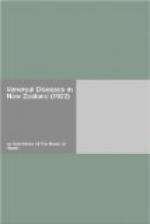Following are the clauses in suggestions for a Bill, drawn up by the Health Department, which in the opinion of the Committee should in substance be adopted:—–
“(1.) Every medical practitioner shall forthwith give notice to the Director-General of Health, in the prescribed form, upon becoming aware that any person attended or treated by him is suffering from any venereal disease in a communicable form. The notice shall state the age and sex and occupation of the patient and the nature of the disease, but shall omit the patient’s name and address.
“(2.) Every medical practitioner, other than the medical officer in charge of a public hospital or of a clinic established by direction of the Minister of Health, shall be paid for each such notification a fee to be prescribed by regulation.
“(3.) The provisions
of subsection (1) hereof shall apply in the
case of a child under
the age of sixteen years who is suffering
from congenital syphilis.
“(4.) Whenever a patient has changed his medical adviser, in accordance with subsection (2) hereof, the medical practitioner under whose care the patient has placed himself shall notify the Director-General of Health in accordance with subsection (1) hereof, and shall include in such notice the name and address of the previous medical adviser.”
Without some such system of preliminary notification no adequate statistics can be collected as to the prevalence of venereal diseases in New Zealand, and no conclusion could be arrived at in the future as to the effect of the whole or any part of the programme for combating these scourges. Again, without such notification, and the attachment thereto of some method of ensuring that the patient is made definitely acquainted with his condition, it is practically impossible to enforce the provisions of section 8 of the Social Hygiene Act for the crime of “knowingly” infecting any other person.
Here the Committee would refer to case 2 quoted above. Of what use is it to provide free clinics if those who make use of them are permitted, as soon as the urgent symptoms are relieved, to disseminate disease broadcast, widening the circle of infection? Again, where is our humanity if no step is to be taken to try to prevent a syphilitic child being born to the man in case 1?
A very valuable result of anonymous notification would be the possibility afforded of observing any unusual “flare-up” or succession of cases, especially in country districts and small towns. Study of case 4 will show the great value it would have been to have a record of an unusual increase of syphilis in that township, giving an opportunity for prompt investigation by the Medical Officer of Health for the district.
(B.) Compulsory Examination and Treatment.




